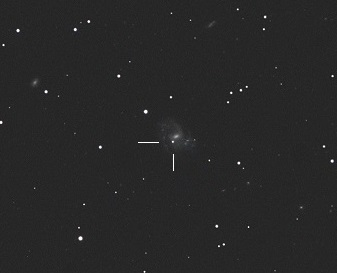
Supernovae
SN 2024bch
 Konojedy, 2024-04-30T23:00:00+02:00, Nikon D5600 mod, SW 100ED APO / 900mm x 0.85, ISO 800, Optolong UV/IR cut, 11 x 300s
Konojedy, 2024-04-30T23:00:00+02:00, Nikon D5600 mod, SW 100ED APO / 900mm x 0.85, ISO 800, Optolong UV/IR cut, 11 x 300s
SN 2024bch
 Konojedy, 2024-04-12T22:52:00+02:00, Nikon D5600 mod, SW 100ED APO / 900mm x 0.85, ISO 800, Optolong UV/IR cut, 19 x 300s
Konojedy, 2024-04-12T22:52:00+02:00, Nikon D5600 mod, SW 100ED APO / 900mm x 0.85, ISO 800, Optolong UV/IR cut, 19 x 300sNote: through cirrus
SN 2024exw
 Konojedy, 2024-03-30T23:00:00+01:00, Nikon D5600 mod, SW 100ED APO / 900mm x 0.85, ISO 800, Optolong UV/IR cut, 19 x 300s
Konojedy, 2024-03-30T23:00:00+01:00, Nikon D5600 mod, SW 100ED APO / 900mm x 0.85, ISO 800, Optolong UV/IR cut, 19 x 300sNote: very bad imaging conditions
M101 and supernova SN 2023ixf
 Konojedy, 2023-06-17T23:30:00+02:00, Nikon D5600, SW 100ED APO / 900mm, ISO 800 8 x 500s
Konojedy, 2023-06-17T23:30:00+02:00, Nikon D5600, SW 100ED APO / 900mm, ISO 800 8 x 500s
A supernova means the complete end of one star.
It is a massive explosion of a star that is 10 times more massive than our Sun and the classic
nuclear fusion of hydrogen has stopped working there. During the explosion, a large amount of
material is released, including heavier elements that were not even initially part of
the star and were produced only at the very end, sometimes just before the explosion.
As stars are usually found in galaxies, supernovae are also found in these places. An explosion rarely occurs in our Milky Way, so these supernovae are usually found in other galaxies.
As stars are usually found in galaxies, supernovae are also found in these places. An explosion rarely occurs in our Milky Way, so these supernovae are usually found in other galaxies.